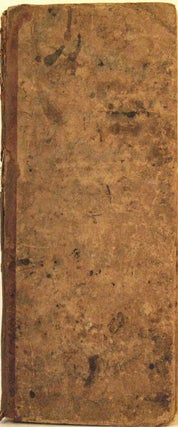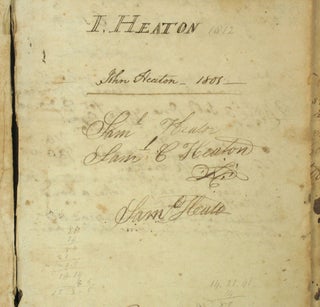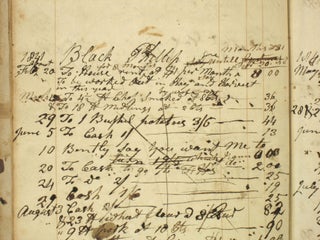Pre Civil War Ledger recording free blacks working at Heaton Family Farm (John Heaton and Samuel Cooper Heaton), Amenia & Washington, Dutchess County New York, 1801-1843.
1801 - 1843. Hardcover. Ledger of some 200 pages with a substantial and detailed record of work performed by free blacks in Dutchess County, New York decades before the Civil War. The ledger begins in 1801 by John Heaton (1776-1827) of Throgs Neck, New York and contains the name, on the first inside page, of his son Samuel Cooper Heaton (born 1811), who apparently took over the ledger and the management of a farm, after his father's death. The Amenia section of the ledger begins in 1810. Other Heaton family names listed include Isaac and Jonah Heaton. The Heatons hired quite a few individuals to work on the farm in Dutchess County who are clearly identified as African Americans. The most frequently hired individual is identified as "Black Philip or Philip Freeman" (Philip is sometimes spelled with two "l"s, and Freeman is also spelled Freman) who also lived at the farm. An entry (page 30) beginning with the date October 23 1841 and carrying through to March 12, 1842 lists the days Phillip worked and his wages at the right column. At the top of the page his rate is $1 per day in October and November; at the middle of the page (December 30), his wage changes to $3 per month: "Philip began to work again for me at $3 per month untill the first of April". There is an interesting note indicating the degree of trust in this relationship: "Philip says he came in my house the middle of Feb 1840 and was to pay $1 Dollar per month for the time he stays in A. I have charged to him page (73) 8 months of it which would make it settled to the middle of October 1841."
Other names of free blacks include "Henry Couloured (sic) Man", "Black Jane Ann (4/per week); "Coloured Man John H. Colden" (there is a single page receipt loosely inserted for a payment on June 3, 1842 for "1 pair fine boots 22/ - box blacking/ 02.88"); and "Martin a Coloured Man".
Dutchess County had a struggling population of employed free blacks prior to the Civil War, with one of the most well-known being James Brown (not mentioned in the ledger), who started working in 1829 as a laborer, coachman and gardener at Mt. Gulian, the historic Fishkill home of the Verplanck family. Brown was an escaped slave born Anthony Fisher in Fredericktown, Maryland in 1793, who escaped to New York City, received assistance from the Verplanck family, became emancipated and returned to the South to purchase the freedom of his wife. Brown kept private journals describing his life in Fishkill spanning the period 1829 to 1866 which are now at the New York Historical Society.
There are many entries from 1840-1843, including those dated at Amenia and Washington, Dutchess County, New York. Names that appear repeatedly during this period include Barbary Van Wyck, Martha Dorlan, Levi Miller, Eli Reed, Court Horton (whose signature appears near the end of the ledger), and Charles Hazelton. The local people were purchasing farm goods from the Heatons. About 10 pages have been cut out. Most of the entries are a straight accounting of receivables, although at the rear there is a full page given to the written contract between Peter Rickey and Court Horton, in which Rickey agrees to work for Horton for a one year term, for the sum of $120, commencing April 1, 1842; it is signed by both parties. Approx. 6.5 by 15.5 inches. From the "Fred W. Haida Collection" of Putnam County NY, stamped on end paper. Quarter brown leather with tan boards; no title. Boards and spine rubbed and marked. Front inner hinge loose, but holding. Item #17839
Sold





